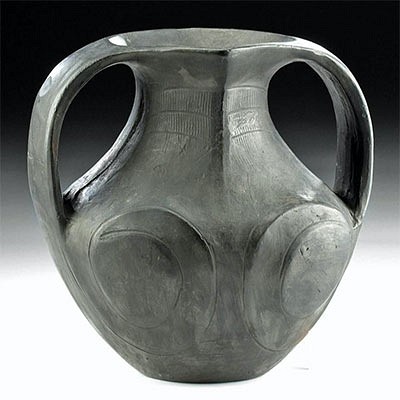Rare / Fine Egyptian Faience Pendant Isis Knot
Lot 3
About Seller
Artemis Gallery
686 S Taylor Ave, Ste 106
Louisville, CO 80027
United States
Selling antiquities, ancient and ethnographic art online since 1993, Artemis Gallery specializes in Classical Antiquities (Egyptian, Greek, Roman, Near Eastern), Asian, Pre-Columbian, African / Tribal / Oceanographic art. Our extensive inventory includes pottery, stone, metal, wood, glass and textil...Read more
Estimate:
$1,200 - $1,800
Absentee vs Live bid
Two ways to bid:
- Leave a max absentee bid and the platform will bid on your behalf up to your maximum bid during the live auction.
- Bid live during the auction and your bids will be submitted real-time to the auctioneer.
Bid Increments
| Price | Bid Increment |
|---|---|
| $0 | $25 |
| $300 | $50 |
| $1,000 | $100 |
| $2,000 | $250 |
| $5,000 | $500 |
| $10,000 | $1,000 |
| $20,000 | $2,500 |
| $50,000 | $5,000 |
| $100,000 | $10,000 |
| $200,000 | $20,000 |
About Auction
By Artemis Gallery
Dec 16, 2021
Set Reminder
2021-12-16 10:00:00
2021-12-16 10:00:00
America/New_York
Bidsquare
Bidsquare : VARIETY SALE | Antiquities & Ethnographic Art
https://www.bidsquare.com/auctions/artemis-gallery/variety-sale-antiquities-ethnographic-art-8026
Featuring classical antiquities, ancient and ethnographic art from cultures encompassing the globe. Egyptian, Greek, Roman, Etruscan, Near Eastern, Asian, Pre-Columbian, Native American, African / Tribal, Oceanic, Spanish Colonial, Russian, Fossils, Fine Art, more! Artemis Gallery info@artemisgallery.com
Featuring classical antiquities, ancient and ethnographic art from cultures encompassing the globe. Egyptian, Greek, Roman, Etruscan, Near Eastern, Asian, Pre-Columbian, Native American, African / Tribal, Oceanic, Spanish Colonial, Russian, Fossils, Fine Art, more! Artemis Gallery info@artemisgallery.com
- Lot Description
Egypt, Late Dynastic Period, 26th to 31st Dynasty, ca. 664 to 332 BCE. A rare example of a mold-formed pendant of a hieroglyph known as the Isis knot ("tet" or "tit" in ancient Egyptian). Also known as the "blood of Isis," the pendant has the flared base of a typical djed pillar but with a knotted loop on top representing the girdle knot worn by many gods. Tet amulets like this one were often placed into the linen wrappings of mummies as potent phylactic symbols meant to protect the deceased during their journey to and through the afterlife. Covered in sky blue glaze, this is a wondrous artifact from ancient Egypt! Size: 0.75" W x 2.18" H (1.9 cm x 5.5 cm)
According to author Manfred Lurker, "This sign, called tet by the Egyptians, resembles the ankh, except that the transverse arms are folded downwards. The blood of Isis is similar in many ways to the knot in the girdle worn by gods. Its original meaning is unknown, but after the New Kingdom the connection with Isis was unequivocal. In the Book of the Dead the sign was addressed with the words, 'O, blood of Isis'. It was placed with the deceased and was supposed to be made of a red, semi-precious stone. The blood of Isis was often combined with the djed-pillar, especially in the decoration of temple walls, beds and sarcophagi. When combined, the two symbols alluded, via Isis and Osiris, to the unity of opposing world forces and with that to the unconquerable nature of life." (Lurker, Manfred. "The Gods and Symbols of Ancient Egypt: An Illustrated Dictionary." Thames & Hudson, London, 1986, p. 72)
Cf. An example from the New Kingdom carved from red jasper at The Metropolitan Museum of Art, accession number 00.4.39
Provenance: private Toronto, Ontario, Canada collection, by descent, acquired in Egypt in 1894 to 1896
All items legal to buy/sell under U.S. Statute covering cultural patrimony Code 2600, CHAPTER 14, and are guaranteed to be as described or your money back.
A Certificate of Authenticity will accompany all winning bids.
PLEASE NOTE: Due to recent increases of shipments being seized by Australian & German customs (even for items with pre-UNESCO provenance), we will no longer ship most antiquities and ancient Chinese art to Australia & Germany. For categories of items that are acceptable to ship to Australia or Germany, please contact us directly or work with your local customs brokerage firm.
Display stands not described as included/custom in the item description are for photography purposes only and will not be included with the item upon shipping.
#167193Small chip to back of left knot strap formed when pendant was first created as evidenced by visible glaze pigment within chipped area. Minor encrustations within some recessed areas, with light pitting, and some small abrasions, otherwise intact and very good. Great preservation to overall form and glaze pigment throughout.Condition
- Shipping Info
-
All shipping is handled in-house for your convenience. Your invoice from Artemis Gallery will include shipping calculation instructions. If in doubt, please inquire BEFORE bidding for estimated shipping costs for individual items.
-
- Buyer's Premium



 EUR
EUR CAD
CAD AUD
AUD GBP
GBP MXN
MXN HKD
HKD CNY
CNY MYR
MYR SEK
SEK SGD
SGD CHF
CHF THB
THB













